The Durable Chitosan Functionalization of Cellulosic Fabrics
Abstract
:1. Introduction
2. Materials and Methods
2.1. Materials
2.2. Chitosan Functionalization
2.3. Maintenance Procedure
2.4. Characterization Methods
3. Results and Discussion
4. Conclusions
Author Contributions
Funding
Institutional Review Board Statement
Data Availability Statement
Acknowledgments
Conflicts of Interest
References
- Struszczyk, M.H. Chitin and Chitosan Part I. Properties and production. Polimery 2002, 47, 316–325. [Google Scholar] [CrossRef]
- Rinaudo, M. Chitin and chitosan: Properties and applications. Prog. Polym. Sci. 2006, 31, 603–632. [Google Scholar] [CrossRef]
- Biswas, M.C.; Jony, B.; Nandy, P.K.; Chowdhury, R.A.; Halder, S.; Kumar, D.; Ramakrishna, S.; Hassan, M.; Ahsan, M.A.; Hoque, M.E.; et al. Recent Advancement of Biopolymers and Their Potential Biomedical Applications. J. Polym. Environ. 2022, 30, 51–74. [Google Scholar] [CrossRef]
- Chellamani, K.P.; Vignesh Balaji, R.S.; Sudharsan, J. Chitosan treated textile substrates for wound care applications. J. Acad. Ind. Res. 2013, 2, 97–102. [Google Scholar]
- Sujka, W.; Draczynski, Z.; Kolesinska, B.; Latanska, I.; Jastrzebski, Z.; Rybak, Z.; Zywicka, B. Influence of Porous Dressings Based on Butyric-Acetic Chitin Co-Polymer on Biological Processes In Vitro and In Vivo. Materials 2019, 23, 970. [Google Scholar] [CrossRef] [PubMed]
- Bano, I.; Arshad, M.; Yasin, T.; Ghauri, M.A.; Younus, M. Chitosan: A potential biopolymer for wound management. Int. J. Biol. Macromol. 2017, 102, 380–383. [Google Scholar] [CrossRef]
- Živanović, S.; Basurto, C.C.; Chi, S.; Davidson, P.M.; Weiss, J. Molecular weight of chitosan influences antimicrobial activity in oil-in-water emulsions. J. Food Prot. 2004, 67, 952–959. [Google Scholar] [CrossRef]
- Sikorski, D.; Gzyra-Jagieła, K.; Draczynski, Z. The Kinetics of Chitosan Degradation in Organic Acid Solutions. Mar. Drugs 2021, 19, 236. [Google Scholar] [CrossRef]
- Enescu, D.; Olteanu, C.E. Use of chitosan in surface modification of textile materials. Chem. Eng. Commun. 2008, 195, 1269–1291. [Google Scholar] [CrossRef]
- Draczyński, Z.; Flinčec Grgac, S.; Dekanić, T.; Tarbuk, A.; Boguń, M. Implementation of Chitosan into Cotton Fabric. Tekstilec 2017, 60, 296–301. [Google Scholar] [CrossRef]
- Knittel, D.; Schollmeyer, E. Chitosans for permanent antimicrobial finish on textiles. Lenzing. Berichte 2006, 85, 124–130. [Google Scholar]
- Lim, S.-H.; Hudson, S.M. Application of a fiber-reactive chitosan derivative to cotton fabric as an antimicrobial textile finish. Carbohydr. Polym. 2004, 56, 227–234. [Google Scholar] [CrossRef]
- El Tahlawy, K.F.; El Bendary, M.A.; Elhendawy, A.G.; Hudson, S.M. The antimicrobial activity of cotton fabrics treated with different crosslinking agents and chitosan. Carbohydr. Polym. 2005, 60, 421–430. [Google Scholar] [CrossRef]
- Öktem, T. Surface treatment of cotton fabrics with chitosan. Color. Technol. 2003, 119, 241–246. [Google Scholar] [CrossRef]
- Zhang, Z.-T.; Chen, L.; Ji, J.-M.; Huang, Y.-L.; Chen, D.-H. Antibacterial Properties of Cotton Fabrics Treated with Chitosan. Text. Res. J. 2003, 73, 1103–1106. [Google Scholar] [CrossRef]
- Strnad, S.; Šauperl, O.; Fras-Zemljič, L. Chapter 9—Cellulose Fibres Functionalised by Chitosan: Characterization and Application. In Biopolymers; Elnashar, M., Ed.; InTechOpen: London, UK, 2010. [Google Scholar] [CrossRef]
- Sauperl, O.; Kostic, M.; Milanovic, J.; Fras Zemljic, L. Chemical Binding of Chitosan and Chitosan Nanoparticles onto Oxidized Cellulose. J. Eng. Fibers Fabr. 2015, 10, 70–77. [Google Scholar] [CrossRef]
- Alonso, D.; Gimeno, M.; Olayo, R.; Vázquez, H.; Sepúlveda-Sánchez, J.; Shirai, K. Cross-linking chitosan into UV-irradiated cellulose fibers for the preparation of antimicrobial-finished textiles. Carbohydr. Polym. 2009, 77, 536–543. [Google Scholar] [CrossRef]
- Hsieh, S.H.; Chen, W.H.; Wei, L.L. A spectroscopic analysis of the reaction mechanism of polycarboxylic acids’ crosslinking with chitosan and cotton fabric. Cellul. Chem. Technol. 2003, 37, 359–369. [Google Scholar]
- Sunder, E.; Nalankilli, G. Croslinking of Chitosan with Cotton using Polycarboxylic Acids. Int. J. Eng. Res. Technol. 2014, 3, 1769–1774. [Google Scholar]
- Chung, Y.-S.; Lee, K.-K.; Kim, J.-W. Durable Press and Antimicrobial Finishing of Cotton Fabrics with a Citric Acid and Chitosan Treatment. Text. Res. J. 1998, 68, 772–775. [Google Scholar] [CrossRef]
- Davidson, G.F. The Rate of Change in the Properties of Cotton Cellulose Under the Prolonged Action of Acids. J. Text. Inst. Trans. 1943, 34, T87–T96. [Google Scholar] [CrossRef]
- Pawlak, A.; Mucha, M. Thermogravimetric and FTIR studies of chitosan blends. Thermochim. Acta 2013, 396, 153–166. [Google Scholar] [CrossRef]
- Flinčec Grgac, S.; Tesla, T.; Čorak, I.; Žuvela Bošnjak, F. Hydrothermal Synthesis of Chitosan and Tea Tree Oil on Plain and Satin Weave Cotton Fabrics. Materials 2022, 15, 5034. [Google Scholar] [CrossRef] [PubMed]
- Flinčec Grgac, S.; Milčić, V.; Vrbić, A. Influence of pre-treatment in an alkaline medium on binding chitosan and 2,3-dihydroxy butandionic acid on cotton and polyester/cotton substrate. In AUTEX 2022 Conference Proceedings; Lodz University of Technology: Łódź, Poland, 2022; pp. 363–367. [Google Scholar]
- Pušić, T.; Kaurin, T.; Liplin, M.; Budimir, A.; Čurlin, M.; Grgić, K.; Sutlović, A.; Volmajer Valh, J. The Stability of the Chitosan Coating on Polyester Fabric in the Washing Process. Tekstilec 2023, 66, 85–104. [Google Scholar] [CrossRef]
- Toshikj, E.; Petrovski, O.; Petrovska, M.; Jordanov, I. Antimicrobial Active Chitosan-Based Cotton Yarns: Effect of Chitosan Solution Concentration. Tekstilec 2023, 66, 116–125. [Google Scholar] [CrossRef]
- Hilal, N.M.; Gomaa, S.H.; Elsisi, A.A. Improving dyeing parameters of polyester/cotton blended fabrics by caustic soda, chitosan, and their hybrid. Egypt. J. Chem. 2020, 63, 2379–2393. [Google Scholar] [CrossRef]
- Flinčec Grgac, S.; Tarbuk, A.; Dekanić, T.; Sujka, W.; Draczyński, Z. The Chitosan Implementation into Cotton and Polyester/Cotton Blend Fabrics. Materials 2020, 13, 1616. [Google Scholar] [CrossRef]
- Kim, Y.H.; Nam, C.W.; Choi, J.W.; Jang, J. Durable Antimicrobial Treatment of Cotton Fabrics Using N-(2-Hydroxy)propyl-3-trimethylammonium Chitosan Chloride and Polycarboxylic Acids. J. Appl. Polym. Sci. 2003, 88, 1567–1572. [Google Scholar] [CrossRef]
- Flinčec Grgac, S.; Biruš, T.-D.; Tarbuk, A.; Malinar, R.; Draczyński, Z. The influence of maleic acid concentration on the binding of chitosan with cotton cellulose. In Proceedings of the 13th International Scientific-Professional Symposium Textile Science and Economy 2020, Zagreb, Croatia, 18 September 2020; University of Zagreb Faculty of Textile Technology: Zagreb, Croatia, 2020; pp. 51–55. [Google Scholar]
- Negi, A.; Kesari, K.K. Chitosan Nanoparticle Encapsulation of Antibacterial Essential Oils. Micromachines 2022, 13, 1265. [Google Scholar] [CrossRef]
- Yang, C.Q.; Wang, X.; Kang, I.-S. Ester Crosslinking of Cotton Fabric by Polymeric Carboxylic Acids and Citric Acid. Text. Res. J. 1997, 67, 334–342. [Google Scholar] [CrossRef]
- Šauperl, O.; Stana-Kleinschek, K.; Sfiligoj-Smole, M.; Etlinger, B. Utjecaj mercerizacije na umrežavanje celuloze 1,2,3,4-butan-tetrakarboksilnom kiselinom (BTCA). Tekstil 2002, 51, 455–462. [Google Scholar]
- Yang, C.Q. Oligomerna maleinska kiselina kao novo sredstvo bez formaldehida za dobivanje trajne otpornosti na gužvanje za pamuk. Tekstil 2007, 56, 116–122. [Google Scholar]
- Peng, H.; Yang, C.Q.; Wang, S. Nonformaldehyde durable press finishing of cotton fabrics using the combination of maleic acid and sodium hypophosphite. Carbohydr. Polym. 2012, 87, 491–499. [Google Scholar] [CrossRef] [PubMed]
- Chen, D.; Yang, C.Q.; Qiu, X. Aqueous polymerization of Maleic Acid and Cross-Linking of Cotton Cellulose by Poly(maleic acid). Ind. Eng. Chem. Res. 2005, 44, 7921–7927. [Google Scholar] [CrossRef]
- Walawska, A.; Filipowska, B.; Rybicki, E. Dyeing Polyester and Cotton-Polyester Fabrics by Means of Direct Dyestuffs after Chitosan Treatment. Fibres Text. East. Eur. 2003, 11, 71–74. [Google Scholar]
- Noppakundilograt, S.; Buranagul, P.; Graisuwan, W.; Koopipat, C.; Kiatkamjornwong, S. Modified chitosan pretreatment of polyester fabric for printing by ink jet ink. Carbohydr. Polym. 2010, 82, 1124–1135. [Google Scholar] [CrossRef]
- Ristić, N.; Jovančić, P.; Canal, C.; Jocić, D. One-bath one-dye class dyeing of PES/cotton blends after corona and chitosan treatment. Fibers Polym. 2009, 10, 466–475. [Google Scholar] [CrossRef]
- ISO 2267:1986; Surface Active Agents—Evaluation of Certain Effects of Laundering—Methods of Preparation and Use of Unsoiled Cotton Control Cloth. International Organization for Standardization: Geneva, Switzerland, 1986.
- ISO 6330:2021; Textiles—Domestic Washing and Drying Procedures for Textile Testing. International Organization for Standardization: Geneva, Switzerland, 2021.
- ISO 13934-1:2013; Textiles—Tensile Properties of Fabrics—Part 1: Determination of Maximum Force and Elongation at Maximum Force Using the Strip Method. International Organization for Standardization: Geneva, Switzerland, 2013.
- ISO 4312:1989; Surface Active Agents—Evaluation of Certain Effects of Laundering—Methods of Analysis and Test for Unsoiled Cotton Control Cloth. International Organization for Standardization: Geneva, Switzerland, 1989.
- ISO 105-J02:1997; Textiles—Tests for Colour Fastness—Part J02: Instrumental Assessment of Relative Whiteness. International Organization for Standardization: Geneva, Switzerland, 1997.
- DIN 6167:1980-01; Description of Yellowness of Near-White or Near-Colourless Materials. German Institute for Standardisation (Deutsches Institut für Normung): Berlin, Germany, 1980.
- AATCC TM 147-2016; Antibacterial Activity Assessment of Textile Materials: Parallel Streak Method. American Association of Textile Chemists and Colorists: Research Triangle Park, NC, USA, 2016.
- Chung, C.; Lee, M.; Choe, E.K. Characterization of cotton fabric scouring by FT-IR ATR spectroscopy. Carbohydr. Polym. 2004, 58, 417–420. [Google Scholar] [CrossRef]
- Brugnerotto, J.; Lizardi, J.; Goycoolea, F.M.; Argüelles-Monal, W.; Desbrières, J.; Rinaudo, M. An infrared investigation in relation with chitin and chitosan characterization. Polymer 2001, 42, 3569–3580. [Google Scholar] [CrossRef]
- Mushtaq, A.; Bin Mukhtar, H.; Mohd Shariff, A. FTIR Study of Enhanced Polymeric Blend Membrane with Amines. Res. J. Appl. Sci. Eng. Technol. 2014, 7, 1811–1820. [Google Scholar] [CrossRef]
- Mendes, J.F.; Paschoalin, R.T.; Carmona, V.B.; Sena Neto, A.R.; Marques, A.C.P.; Marconcini, J.M.; Mattoso, L.H.C.; Medeiros, E.S.; Oliveira, J.E. Biodegradable polymer blends based on corn starch and thermoplastic chitosan processed by extrusion. Carbohydr. Polym. 2016, 137, 452–458. [Google Scholar] [CrossRef] [PubMed]


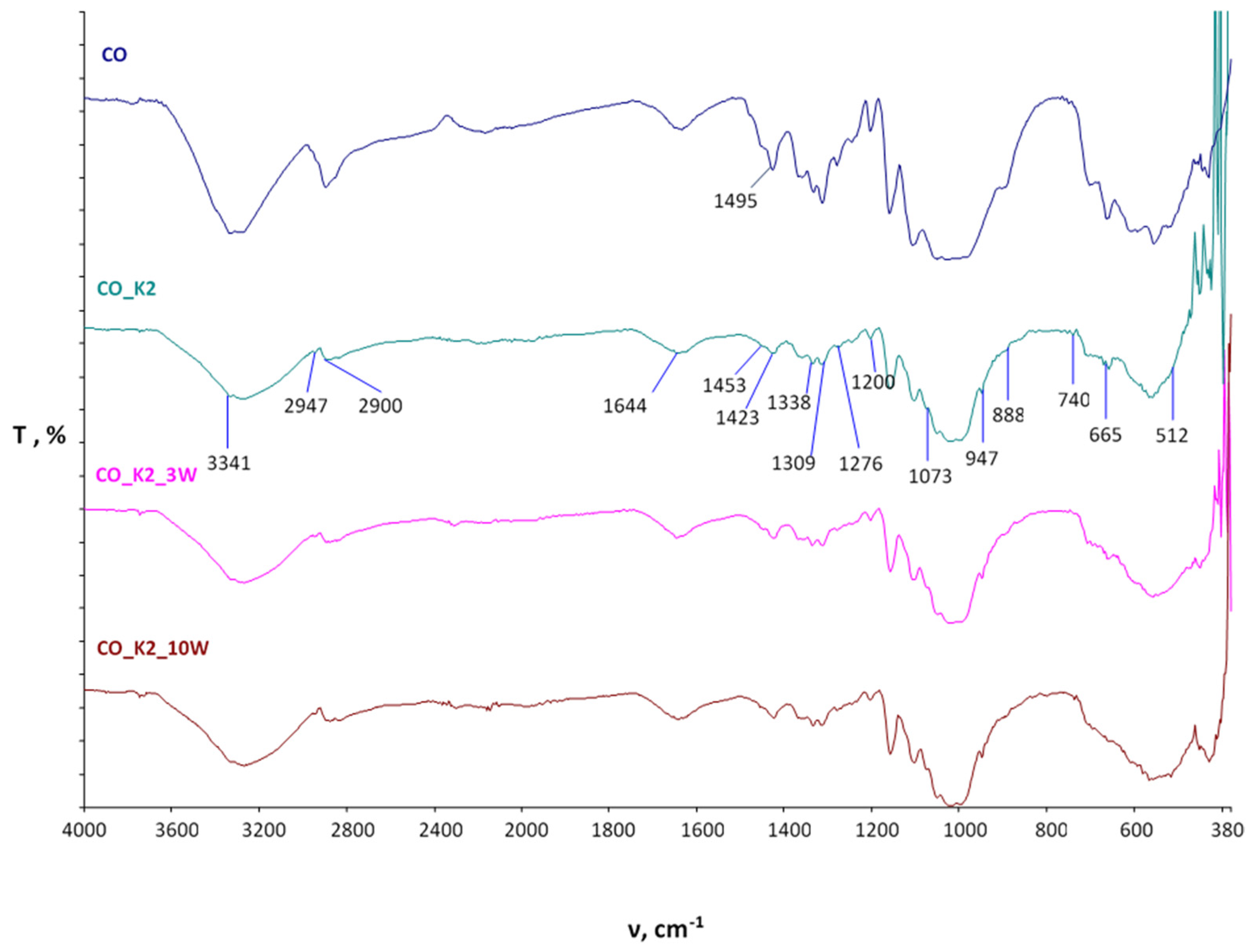
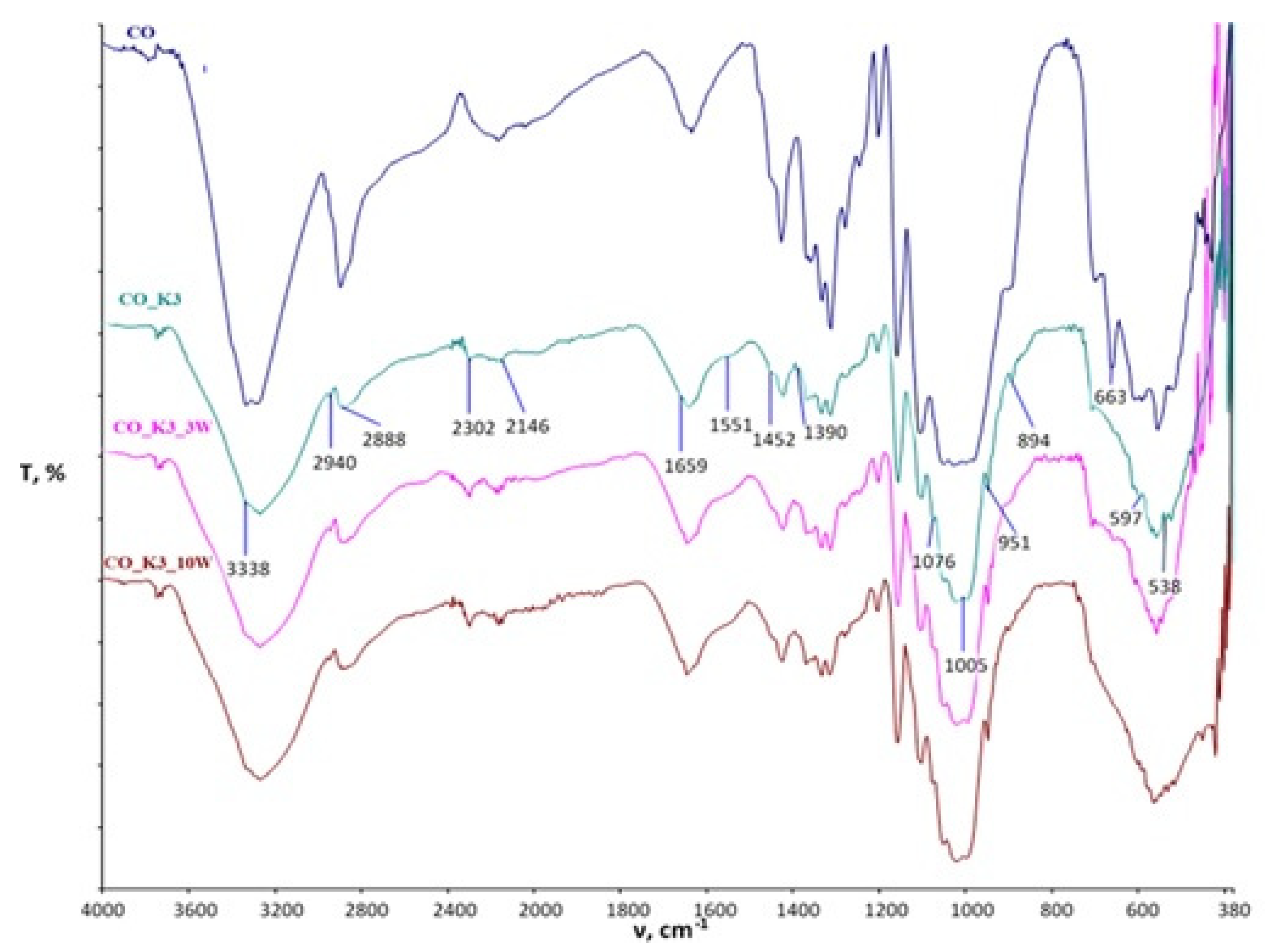
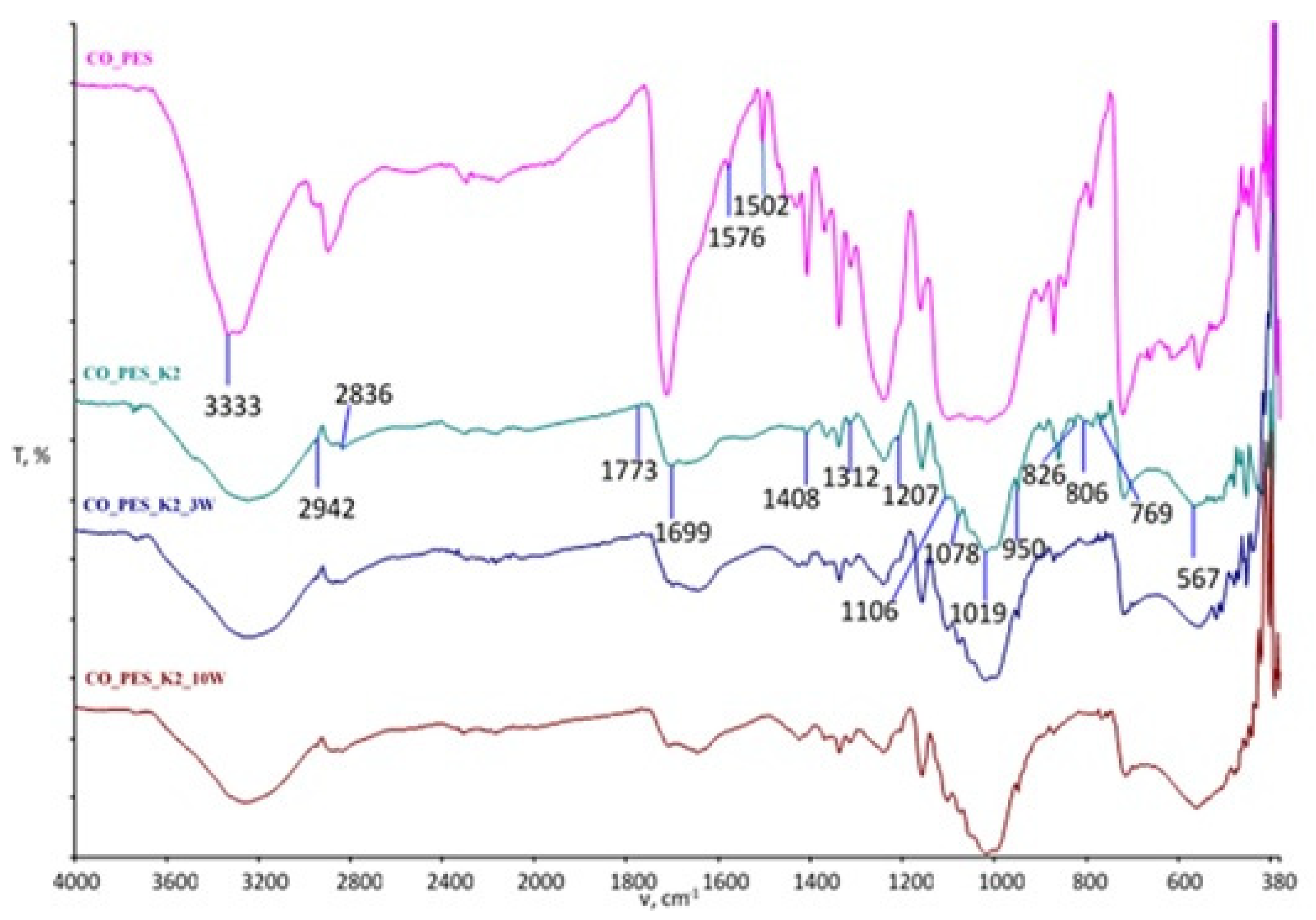
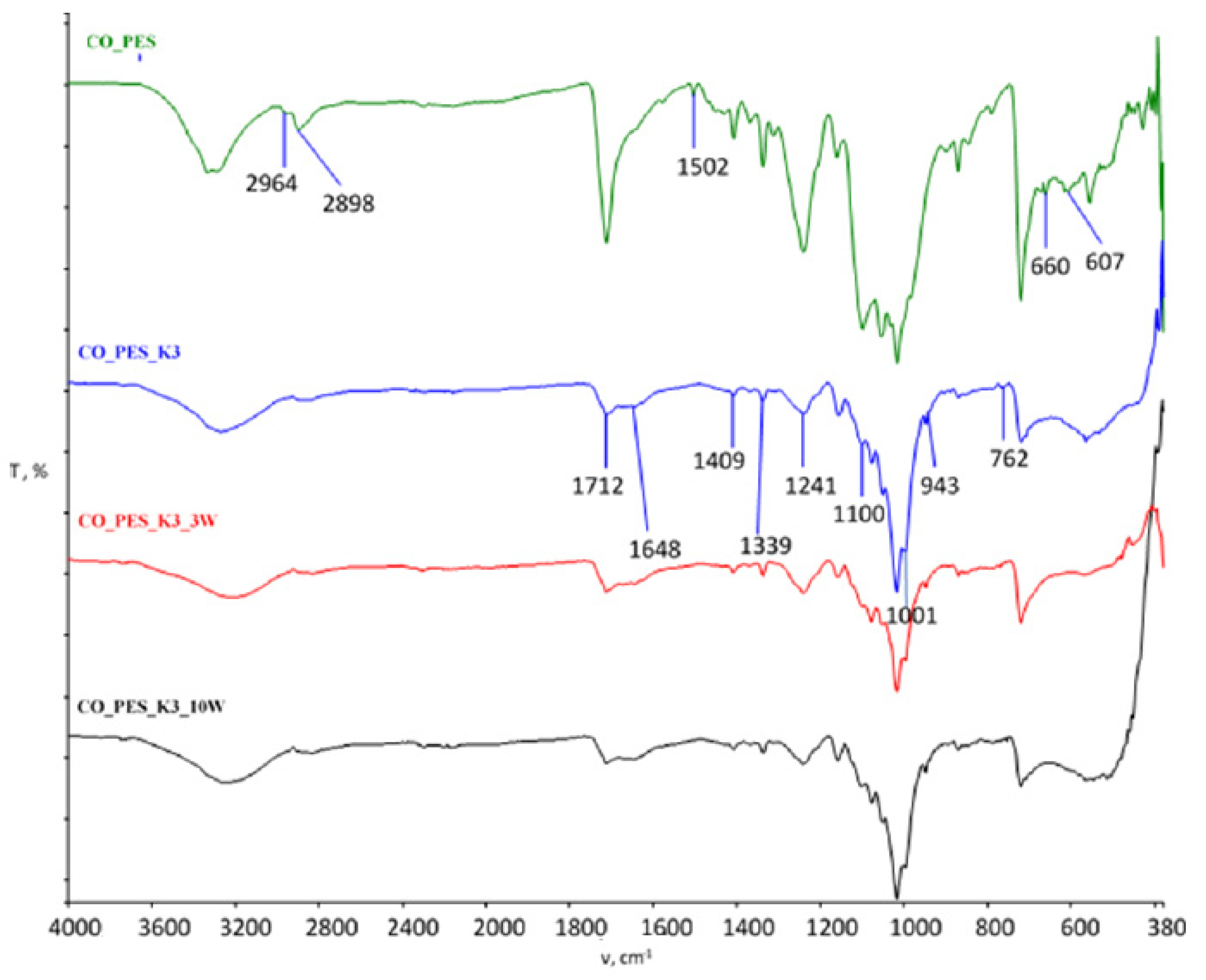
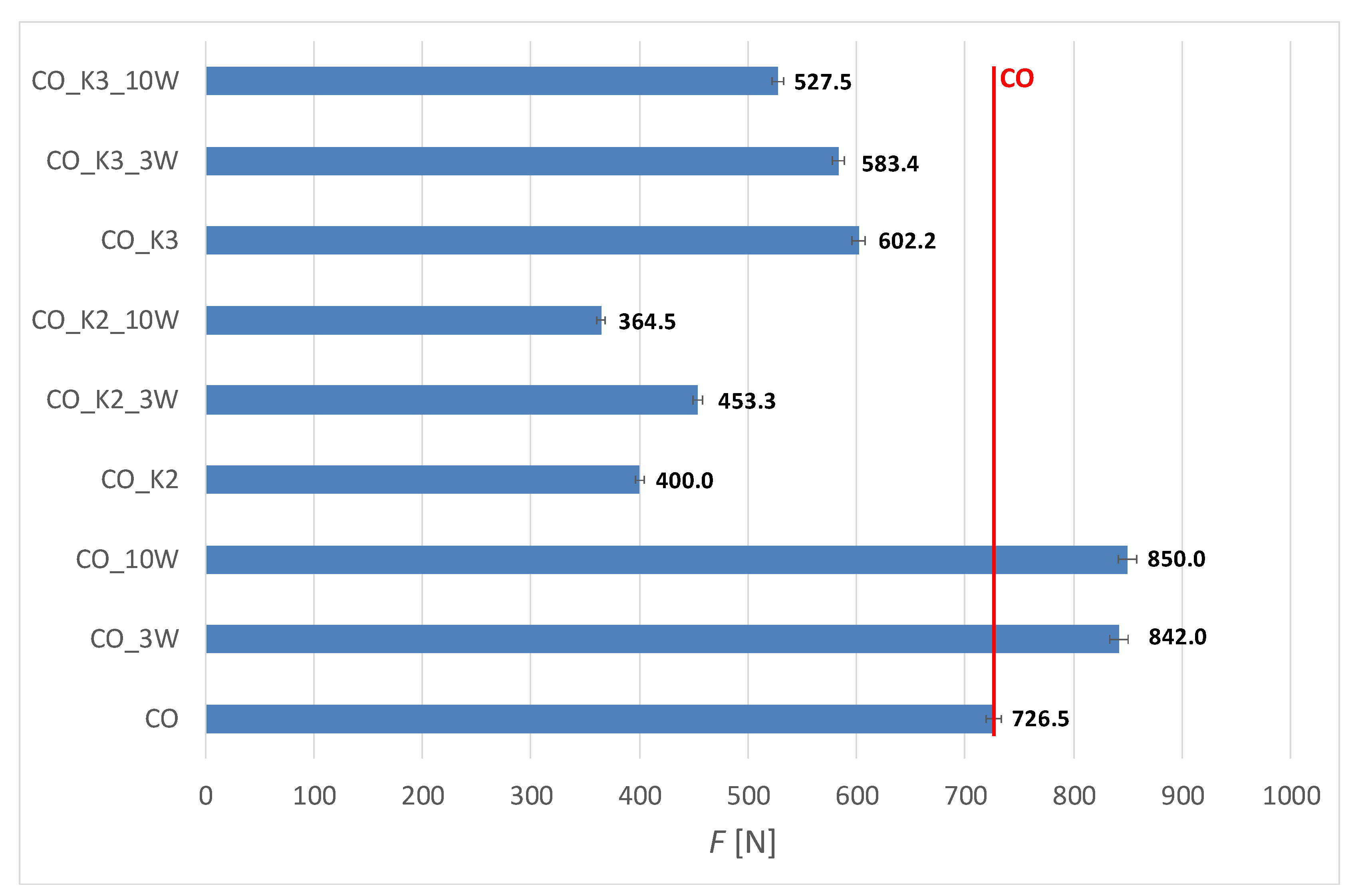
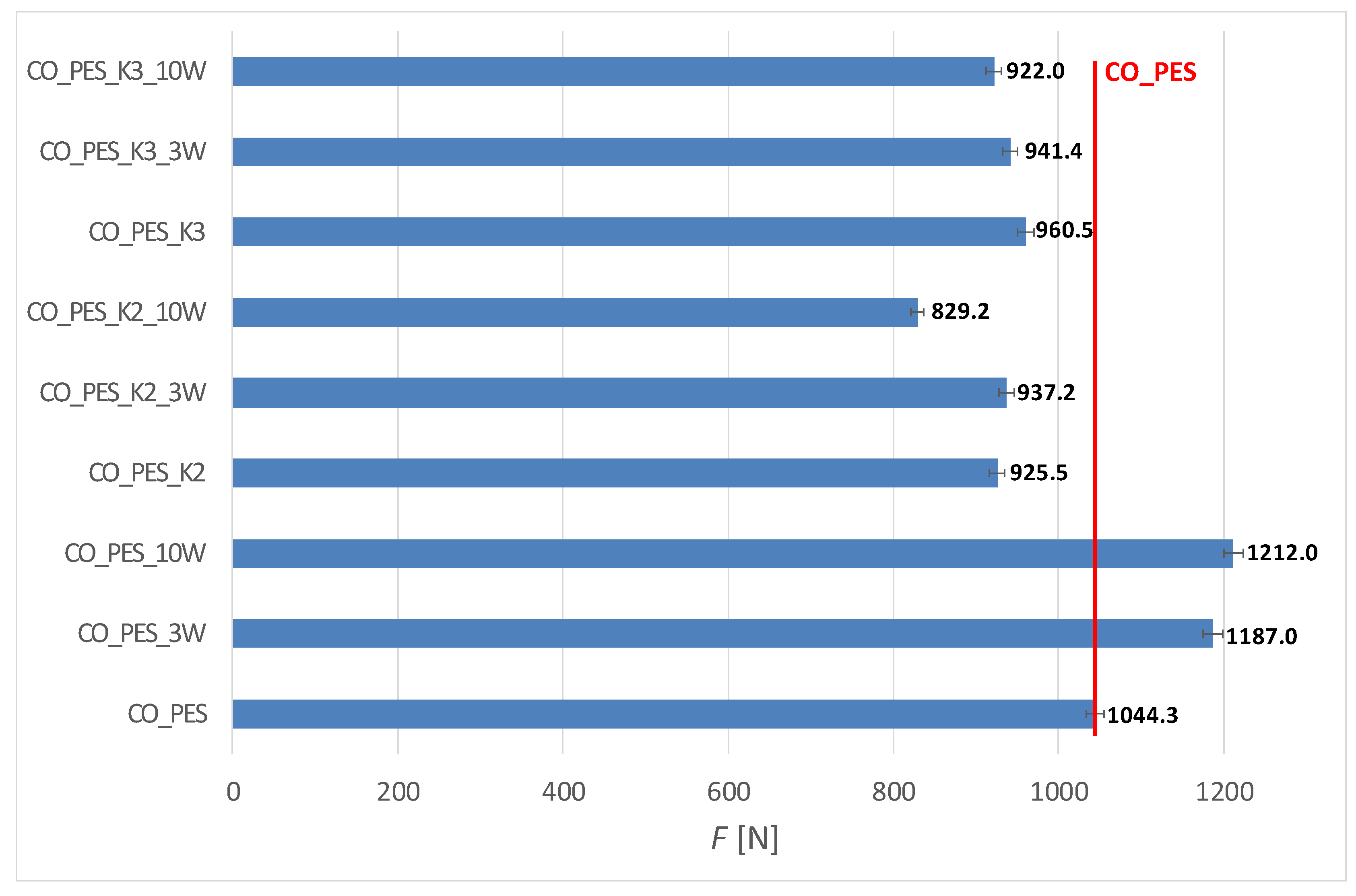

| Label | Fabric Description |
|---|---|
| CO | Cotton standard fabric (WFK label 10A) |
| CO_PES | Cotton/polyester blended fabric (WFK label 20A) |
| _K2 | Chitosan functionalized cellulosic fabric with MA as crosslinking agent |
| _K3 | Chitosan functionalized cellulosic fabric with BTCA as crosslinking agent |
| _3W | Chitosan functionalized cellulosic fabric after 3 maintenance cycles |
| _10W | Chitosan functionalized cellulosic fabric after 10 maintenance cycles |
| Label | ε [%] | Um [%] | Um related pair [%] |
|---|---|---|---|
| CO | 14.90 | 0.00 | - |
| CO_3W | 17.70 | −15.90 | - |
| CO_10W | 16.65 | −17.00 | - |
| CO_K2 | 18.80 | 44.94 | 44.94 |
| CO_K2_3W | 20.88 | 37.60 | 46.16 |
| CO_K2_10W | 18.10 | 49.83 | 57.12 |
| CO_K3 | 18.15 | 17.11 | 17.11 |
| CO_K3_3W | 18.60 | 19.70 | 30.72 |
| CO_K3_10W | 17.70 | 27.39 | 37.94 |
| Label | ε [%] | Um [%] | Um related pair [%] |
|---|---|---|---|
| CO_PES | 14.90 | 0.00 | - |
| CO_PES_3W | 17.70 | −13.66 | - |
| CO_PES_10W | 16.65 | −16.06 | - |
| CO_PES_K2 | 18.80 | 11.38 | 11.38 |
| CO_PES_K2_3W | 20.88 | 10.26 | 21.05 |
| CO_PES_K2_10W | 18.10 | 20.60 | 31.58 |
| CO_PES_K3 | 18.15 | 8.03 | 8.03 |
| CO_PES_K3_3W | 18.60 | 9.86 | 20.69 |
| CO_PES_K3_10W | 17.70 | 11.71 | 23.93 |
| Fabric | CO_ | CO_PES_ | ||
|---|---|---|---|---|
| W | YI | W | YI | |
| _ | 73.4 | 4.37 | 74.8 | 3.28 |
| _K2 | 49.0 | 12.38 | 60.9 | 8.16 |
| _K2_3W | 73.8 | 4.29 | 70.1 | 5.14 |
| _K2_10W | 77.8 | 2.62 | 78.9 | 2.01 |
| _K3 | 48.2 | 12.94 | 54.6 | 10.66 |
| _K3_3W | 73.5 | 4.47 | 67.4 | 6.15 |
| _K3_10W | 83.5 | 0.83 | 70.6 | 4.99 |
| Fabric | Staphylococcus aureus | Escherichia coli | Candida albicans | |||
|---|---|---|---|---|---|---|
| CO_ | CO_PES_ | CO_ | CO_PES_ | CO_ | CO_PES_ | |
| _ | − | − | − | − | − | − |
| _K2 | − | − | − | − | +/− | +/− |
| _K2_3W | − | − | − | − | +/− | +/− |
| _K2_10W | − | − | − | − | +/− | +/− |
| _K3 | − | − | − | − | +/− | +/− |
| _K3_3W | − | − | − | − | +/− | +/− |
| _K3_10W | − | − | − | − | +/− | +/− |
Disclaimer/Publisher’s Note: The statements, opinions and data contained in all publications are solely those of the individual author(s) and contributor(s) and not of MDPI and/or the editor(s). MDPI and/or the editor(s) disclaim responsibility for any injury to people or property resulting from any ideas, methods, instructions or products referred to in the content. |
© 2023 by the authors. Licensee MDPI, Basel, Switzerland. This article is an open access article distributed under the terms and conditions of the Creative Commons Attribution (CC BY) license (https://creativecommons.org/licenses/by/4.0/).
Share and Cite
Flinčec Grgac, S.; Biruš, T.-D.; Tarbuk, A.; Dekanić, T.; Palčić, A. The Durable Chitosan Functionalization of Cellulosic Fabrics. Polymers 2023, 15, 3829. https://doi.org/10.3390/polym15183829
Flinčec Grgac S, Biruš T-D, Tarbuk A, Dekanić T, Palčić A. The Durable Chitosan Functionalization of Cellulosic Fabrics. Polymers. 2023; 15(18):3829. https://doi.org/10.3390/polym15183829
Chicago/Turabian StyleFlinčec Grgac, Sandra, Tea-Dora Biruš, Anita Tarbuk, Tihana Dekanić, and Ana Palčić. 2023. "The Durable Chitosan Functionalization of Cellulosic Fabrics" Polymers 15, no. 18: 3829. https://doi.org/10.3390/polym15183829
APA StyleFlinčec Grgac, S., Biruš, T.-D., Tarbuk, A., Dekanić, T., & Palčić, A. (2023). The Durable Chitosan Functionalization of Cellulosic Fabrics. Polymers, 15(18), 3829. https://doi.org/10.3390/polym15183829









